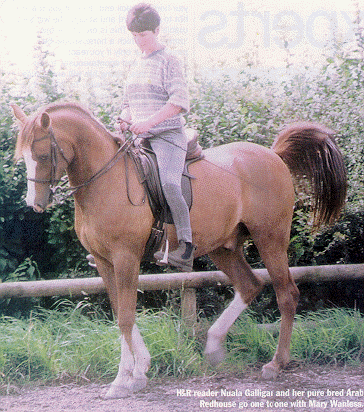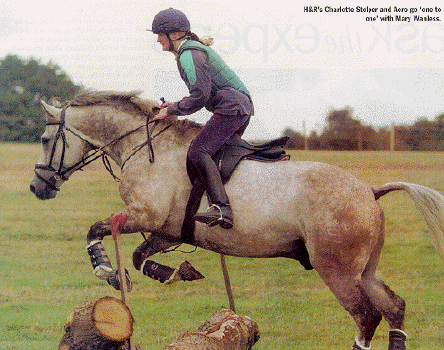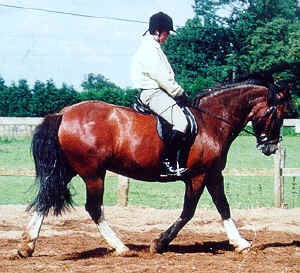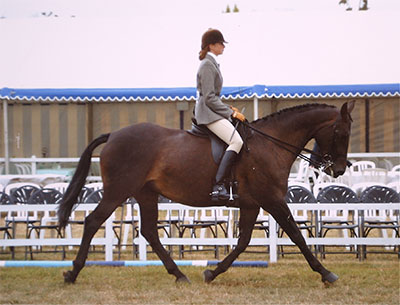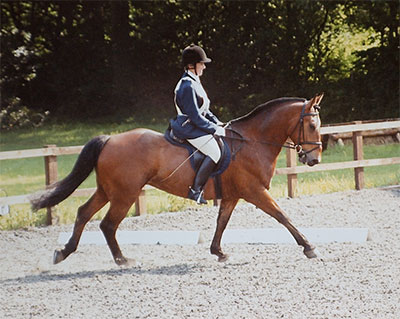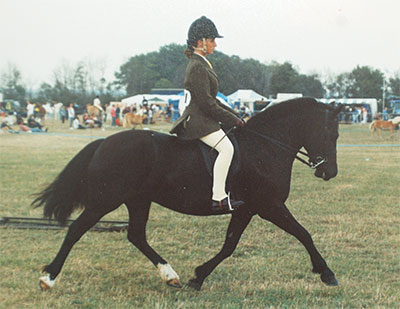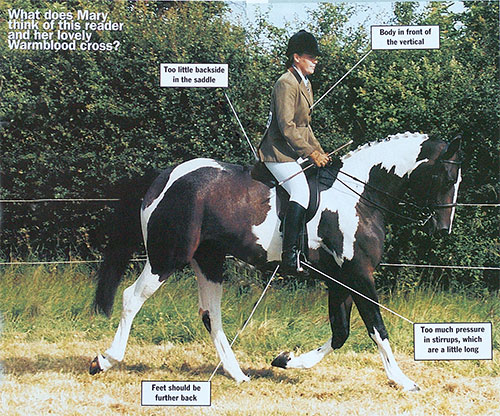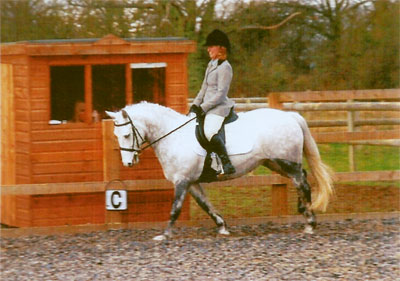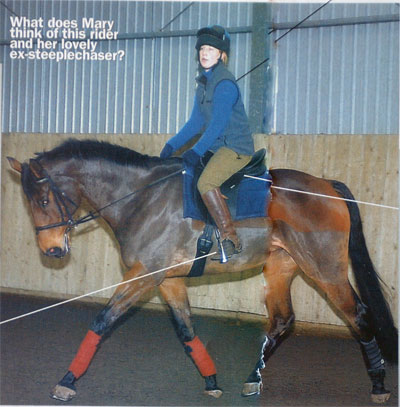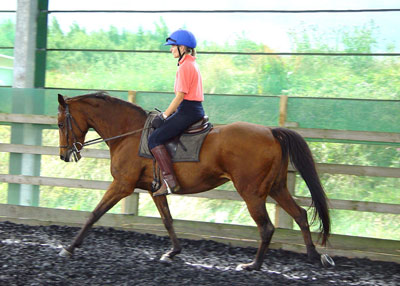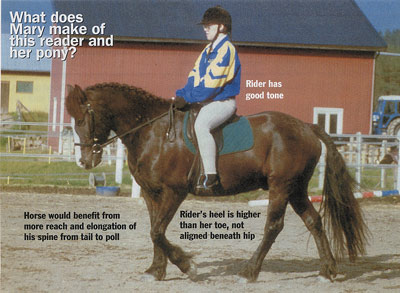RWYM
ARTICLE 3
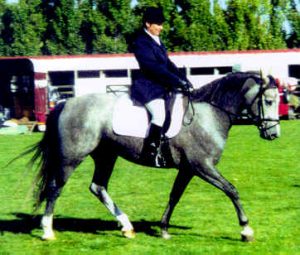 This photograph has been sent from New Zealand, and it shows a four year old Andalusian/Anglo Arab cross mare. She was bred and started by her rider who describes herself as ‘older’. She took to dressage a couple of years ago after her children had come up through the Pony Club system, and this was her first attempt at starting a horse. She tells me that she has ‘had a ball learning what to do’, and says that her horse is ‘basically quiet, forward moving, and tries to please’. This photo was taken at her first ever outing to an Equestrian Federation Dressage Tournament, where she scored 68% and 69.5% in two Preliminary tests.
This photograph has been sent from New Zealand, and it shows a four year old Andalusian/Anglo Arab cross mare. She was bred and started by her rider who describes herself as ‘older’. She took to dressage a couple of years ago after her children had come up through the Pony Club system, and this was her first attempt at starting a horse. She tells me that she has ‘had a ball learning what to do’, and says that her horse is ‘basically quiet, forward moving, and tries to please’. This photo was taken at her first ever outing to an Equestrian Federation Dressage Tournament, where she scored 68% and 69.5% in two Preliminary tests.
This looks and sounds like the kind of little horse that many riders would enjoy handling and riding, and having made such a good start both at home and in competition, one hopes that the road will continue to be smooth. We all know that life is such that there are bound to be a few hiccups, and that the straight and narrow path of continuous improvement is almost certainly a myth. ‘Onwards and upwards’ is a great ideal that is rarely lived out.
Our rider hopes to turn her horse into an ‘all round Riding Club mount’, which is well within the bounds of possibility. (If she is including jumping in her definition of ‘all round’, I am assuming that her horse is jumping tiny jumps happily.) But I think she could aim for more. I increasingly think that within the sphere of dressage there are two kinds of riders, and I hope to encourage a ‘third way’ which avoids the traps inherent in both positions. There are those who are content to ride preliminary dressage tests forever, and those who have great ambitions that will not be satisfied until they reach Prix St George – whatever the cost to the horse.
In the ‘third way’ people would progress up through the competitive grades in the way a young horse is ideally supposed to. But few riders either have, or learn ‘en route’, the skills that are required. The truth is that most people have at least one ‘sacrificial horse’, who they ride without enough skill or respect to be ethical in their approach. They might be determinedly competitive, or just putzing around, but either way they are doing that horse a disservice. Hopefully, they then meet a good trainer who helps them dig themselves out of the holes they have dug themselves into. Depending on how easily they turn things around, that horse may remain their sacrificial horse (but will, we hope, be the last of the line), or he may become their ‘laboratory horse’.
This is the horse on which they discover how the rider/horse interaction works. When you reach this stage, your riding may not always be brilliant, but you are heading in the right direction, and working it out as you go along. This rider could, in theory, go up through the competition grades making that ideal progression, but she is likely to find that the lateral movements pose her some big difficulties that keep her in the laboratory. More likely, she will make that progression on her next horse, who will benefit from all the learnings on the other two, and will not have to suffer her inept attempts at riding.
Some of the people who come on my courses arrive saying ‘I’m only a happy hacker, and I do the odd competition, but I want to ride my horse in a way that does not hamper him. I want to know that I’m being ethical.’ What usually happens is that they get to this stage and find it so exciting and satisfying that they want to learn more! But it is fine to choose to stop there, and horses do not stand in their stables thinking ‘This is terrible. I’ve been wasted. I’m seven, and I ought to be at medium by now!’
However, it saddens me enormously when the choice not to progress has been imposed on the rider through resignation. This happens when she becomes convinced that she does not have the talent to go further, and resigns herself to doing her prelims at the same skill level. This dooms her to keep making the same mistakes over and over again. This is a completely different ball game to learning from experience, perceiving the rider/horse interaction with increasing clarity, and discovering that your skills are growing – even if you make the choice to keep entering prelims.
I look forward to the day when the vast majority of riders receive lessons which give them the basic skills that their horses need them to have. And I also imagine how ordinary riders, with nice but ordinary horses, can work their way up through the competition grades, without being considered – by themselves or others – to be an elite group of privileged riders (and also without being looked down upon because they are not riding large expensive warmbloods). In the ‘third way’ they become learning riders, who already have good baselines, and are working hard, honing their skills as they go.
So, if our rider can get the right help, she could hope and aim for more than a nice riding club horse, and this photograph shows such a good beginning that I am sure more is possible. There is a wonderfully attentive look on this mare’s face, and her ears are out sideways, implying that she is paying attention to the rider instead of looking at the view. She is reaching nicely into the rein – although I think there is more to go, and that the rider needs to discover (if she does not know already) how to get her to reach forward and down. The horse is almost certainly not tracking up, and the hind foot will not reach forward enough to step into the hoof print of the forefoot. But since she is a four year old at her first show, I think we can forgive her.
The first change the rider needs to make is to get the hollow out of her back. It looks enormous, and I would not be surprised if she has back pain as a result. However, it is affecting the horse far less than I would expect. The rider, to her credit, has a very nice line from the elbow through the rein to the horse’s mouth, and the contact looks to be light but there. With the photograph taken from this angle we cannot be completely sure whether she would land on the arena on her feet if we took her horse out from under her by magic, but she is certainly not far off.
Riders with a very hollow back usually have their stirrups too long and their thigh too vertical, but her stirrup length looks sensible, and her thigh must be close to the ideal of 45 degrees to the ground. Her jacket and the angle of the photograph may well be exaggerating the curves of her back. I suspect this because (given the look of her back) her chest is not as raised as I would expect. A good rule of thumb is that your chest should not aim any higher than the horse’s ears, and dropping the chest like this makes many riders feel as if they are slouching.
Another useful landmark is that your pubic bone, belly button, sternum and collar bone should be in a straight vertical line. I think this rider will be surprised by the feeling of putting her collar bone over her sternum – she will then feel as if she is leaning forward as well as slouching! But notice how her shoulder blades are way further back than her waist band; they too should be much closer to lined up vertically. I think she needs to alter her posture to protect her discs from degeneration, and I hope she will be motivated by the thought of pain-free riding in her old age. For her own sake as well as her horse’s, has to ‘go for it’, even if she considers that she is made with a hollow back, and that the change initially seems impossible.
As ever, the change this rider needs to make will feel much larger than it looks, and she will be tempted not to stray this far from ‘home’. Getting feedback from an objective observer could make all the difference to her willingness to feel weird, and a video camera and/or some good mirrors would help too.
Often, people only make changes of this magnitude when things are going wrong and they are desperate. Things are going wonderfully right for this rider, but I hope she will still be motivate enough to make the change she needs. The key questions may well be, ‘Is she content to win at the level in which she is competing now, or does she want to win at a higher level?’ and ‘Does she want to be pain free in her old age?’ If she does – and if she wants her work to be as correct and ethical as possible – she will need to make this change, and the sooner she does it the more she will gain.


